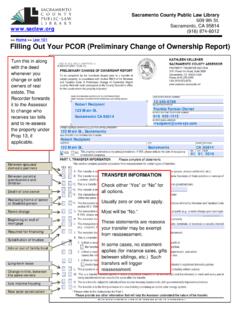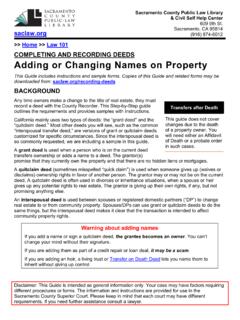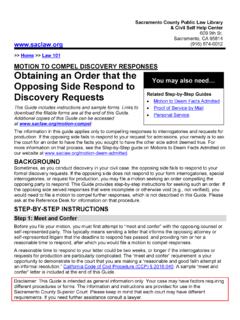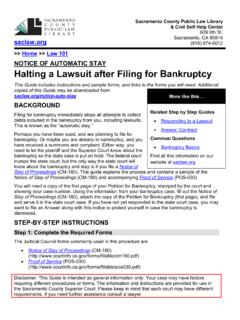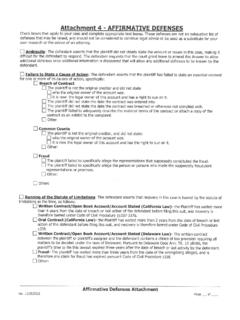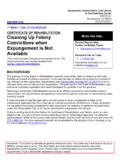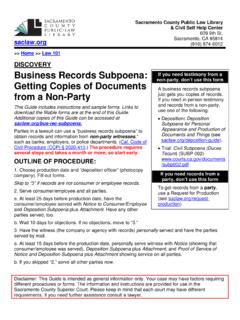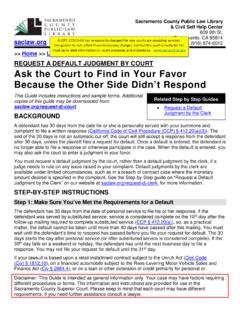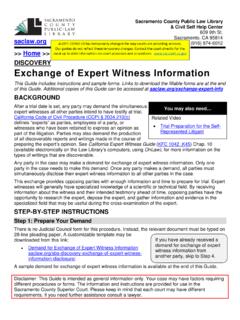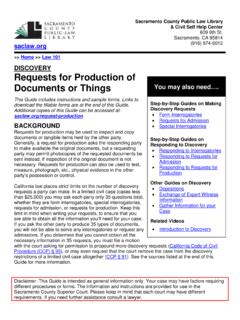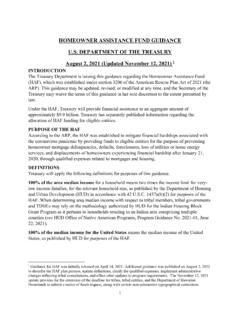Transcription of TRANSFER ON DEATH (TOD) DEEDS Naming Beneficiaries …
1 >> Home >> Law 101 Disclaimer: This Guide is intended as general information only. Your case may have factors requiring different procedures or forms. The information and instructions are provided for use in the Sacramento County Superior Court. Please keep in mind that each court may have different requirements. If you need further assistance consult a lawyer. Sacramento County Public Law Library & Civil Self Help Center 609 9th St. Sacramento, CA 95814 (916) 874-6012 TRANSFER ON DEATH (TOD) DEEDS Naming Beneficiaries and Revoking TOD DEEDS This Guide includes instructions and sample filled-out forms. The Guide and related forms may be downloaded from: BACKGROUND The Revocable TRANSFER on DEATH deed , also called TOD deed or beneficiary deed , is a simple way to leave your residence to your Beneficiaries without the need for probate.
2 The current owner or transferor names the intended heirs as Beneficiaries . The deed has no effect until the transferor dies, so you can change your mind, refinance, or sell the property if you choose. When you die, the Beneficiaries receive the property without going to court, although they do have to notify all heirs and file or record several documents. This guide provides instructions and samples for: 1. Filling Out and Recording a TOD deed 2. Revoking a TOD deed Beneficiaries who are transferring real estate into their name should use our guide Clearing Title after a DEATH (coming soon). A TOD deed is intended to be an inexpensive way to plan who inherits your home after you die.
3 It can only be used to TRANSFER a property with one to four residential dwelling or condominium units, or a single-family residence with less than 40 acres of agricultural land. A mobile home may be transferred only if it is a fixture. Advantages: Avoids probate, if done correctly and if no unexpected family changes occur (like Beneficiaries who die before transferor); Simple, inexpensive alternative to a living trust or other probate avoidance techniques; Can be revoked at any time during the lifetime of the transferor; Same tax advantages as transfers by trust or inheritance under a will. Disadvantages: Technical requirements are simple but very strict, and errors can void the TOD deed ; Beginning 2022, TOD DEEDS must now be signed by two witnesses, and after the donor dies, the Beneficiaries must notify all heirs and file multiple papers.
4 Recent Changes to the Law TRANSFER on DEATH (TOD) deed >>Home >>Law 101 2 The home is not protected from your debts. If you die with a mortgage or other debt, your Beneficiaries may get nothing; Title companies may refuse to issue title insurance for three years after your DEATH , blocking sales or refinancing of the property; If a beneficiary dies before the transferor, their share won t go to their heirs. Instead, the remaining Beneficiaries split it. If no Beneficiaries survive, your home will probably need to go through probate; After your DEATH , the Beneficiaries must take several steps to TRANSFER the property, including notifying any possible heirs, allowing them to challenge the TOD deed .
5 FILLING OUT AND RECORDING A TOD deed Download a blank Revocable TRANSFER on DEATH (TOD) deed form from our website at Step 1: Locate the Current deed for the Property You will need information from your current deed (the deed you received when you bought or received the property) in Step 2. If you do not have a copy of the current deed , you can purchase one from the Recorder s Office. In Sacramento, this costs $1 per page. You can call the Sacramento office at (916) 874-6334 or visit one of the office locations (see for addresses and more information). Make sure you are looking at the deed which gives you ownership of the property. Look for a name like Grant deed , Quitclaim deed , Interspousal deed , Corporation deed , or TRANSFER deed .
6 Ignore any deed of trust . That is related to the mortgage on your property. It will not have all the information you need. Step 2: Read the Common Questions Listed on Page 2 of the TOD deed Before you sign the deed , you are required to read the questions and answers about how the TOD deed works. They are written in small type on page three and four contain important information you need to know prior to filling out the deed , including how to complete it; how to revoke it; its effects on taxes, Medi-Cal eligibility and reimbursement requirements; and more. If you co-own the property as joint tenancy or community property with right of survivorship, the other owner receives your share of the property upon your DEATH .
7 The TOD deed has no effect unless you outlive your co-owner. If co-owners want to use a TOD deed , they must each sign a separate one. Prefer a larger version? Download a large-print version of the common questions from our website ( ) TRANSFER on DEATH (TOD) deed >>Home >>Law 101 3 Step 3: Fill Out the TOD deed (Do Not Sign) The TOD deed can be typed, filled out online then printed, or neatly handwritten in dark blue or black ink. You will need the following information: Assessor s Parcel Number. Your name as spelled on the current deed . Names of Beneficiaries (your intended heirs), and their relationship to you. The legal description of the property.
8 This must match the current deed exactly. Attach the legal description as an exhibit if it is too long for the page. A sample completed Revocable TRANSFER on DEATH (TOD) deed with more detailed instructions is available at the end of this guide. Step 4: Sign in Front of a Notary; Have Two Witnesses Sign You will need to sign the TOD deed in front of a notary. The notary will charge a fee for this service. You can find notaries at many banks, mailing services, and title companies. Two witnesses need to sign. Their signatures do not need to be notarized. They must either witness you signing, or witness you acknowledging the form. (In other words, you must tell them, in person, what the form is and that you have signed it.)
9 Beneficiaries do not need to sign the TOD deed , but it is legal for them to be a witness. However, if anyone challenges the TOD deed , the court must presume that the beneficiary/witness tricked or forced you to sign, and must invalidate the deed unless the beneficiary can prove otherwise. Step 5: Record the deed at the Recorder s Office within 60 Days of Signing It You must record a TOD deed within 60 days of notarizing it or it becomes invalid. Record the TOD deed in the county where the property is located. The Recorder s Office charges a recording fee and additional fees as set by state law. Current Sacramento fees are available at the County Clerk/Recorder s website at REVOKING A TOD deed You can revoke a TOD deed at any time for any reason.
10 If you sell the property, the deed is automatically revoked. To revoke it without selling it, fill out and record a Revocation of Revocable TRANSFER on DEATH (TOD) deed . Download the Revocation of Revocable TRANSFER on DEATH (TOD) deed form from our website at TRANSFER on DEATH (TOD) deed >>Home >>Law 101 4 Step 1: Locate your TOD deed for the Property You will need information from your TOD deed in Step 2. If you do not have a copy of your TOD deed , you can purchase one from the Recorder s Office. In Sacramento, this costs $1 per page. You can contact the Sacramento office at (916) 874-6334 or visit one of the office locations (see for addresses and more information).
